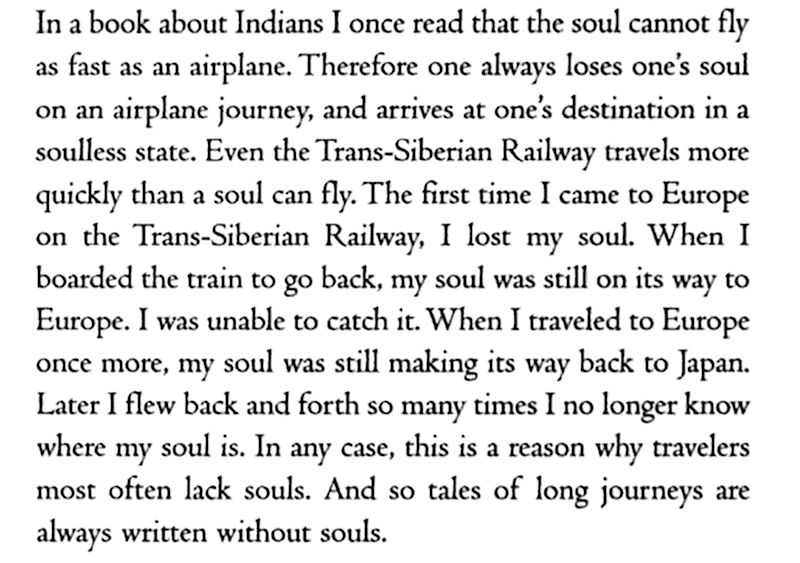Essay
On Flying, Talismanic Tarmacs, and Soul Delay
1/24/2019
Meg Miller
In a piece for Bidoun on men who unwittingly become gods, Anna Della Subin calls the airport tarmac a “temple of accidental deity.” After describing a clumsy welcome in an Oklahoma airport given to the Ethiopian emperor Haile Selassie, famously deified by the Rastafarians, she moves on to John Frum, who inspired a religion on the island of Vanuatu, the followers of which are called Frumists:
The first record of the worship of “John From America,” or John Frum, dates back to 1940, when reports from British colonial administrators on the island of Tanna in New Hebrides, today’s Vanuatu, warned that the natives had all stopped going to church and spoke of an American who existed in two places at once—beneath the seething red lava of the Mount Yasur volcano and in the United States, from whence he would arrive one day in an airplane, bringing with him great wealth. The prophecies came true two years later, when the US Army descended in a flurry of strange gear, military drills, and marching bands. The Americans occupied Tanna until 1945, only to vanish as suddenly as they had come, leaving behind lonely offshore islands of discarded supplies. Frumists dreaming of John’s return began to build airstrips and control towers, constructed an iconography of red wooden crosses and model aircraft, and enshrined as holy relics old Army jackets with sergeant’s stripes.
I was thinking about Frum and the mythic quality of “existing in two places at once” a couple of weeks ago, while sitting by the windows overlooking a tarmac at the Copenhagen airport. The time of day appeared to be morning, though it was hard to be sure having just flown eastward overnight, disappearing whole swaths of time in the process. Who knows what time it was for all the other airport patrons walking around purposefully with their rolling bags in tow.
There’s a weird timelessness to airports that seems to be matched by the generic placeleness of airport architecture. Being in an airport, especially for a layover, always feels a little like purgatory.

While serving my time, I was reminded of a passage from a book by Yoko Tawada that describes arriving somewhere after air travel as a “soulless state,” since souls can't travel as quickly as airplanes can. When it comes to cross-continental trips especially, they’re always lagging behind.

In late summer, on the rooftop of Are.na’s offices in Chinatown, Cab told me about an almost identical passage in William Gibson’s Pattern Recognition. It goes a bit further, relating the case of soul delay to jet lag.
She knows, now, absolutely, hearing the white noise that is London, that Damien’s theory of jet lag is correct: that her mortal soul is leagues behind her, being reeled in on some ghostly umbilical down the vanished wake of the plane that brought her here, hundreds of thousands of feet above the Atlantic. Souls can’t move that quickly, and are left behind, and must be awaited, upon arrival, like lost luggage.
I told this theory to another friend recently and his response was to wonder about the opposite: If after flight our souls experience a period of misalignment, he wrote in an email, six hours ahead of me, “I would be interested to track down the moments the soul is on the right spot, and not ahead of or behind us.”

We decided after some discussion that those were mostly small, quiet moments of peace.

I thought about it later watching Wings of Desire, a movie about angels flying over and through the streets (and libraries) of Berlin, aligning people’s souls, giving them small moments of peace.
Writing this now, I realized that I've always thought of nostalgia as a longing for a place in time, to which, unlike a physical place, one can’t ever return. It's possible the whole business of soul alignment is just about being at the right time in the right place.
In her book Flights, Olga Tokarczuk suggests that might be why people travel, because we believe that “there exists in the world’s coordinate system a perfect point where time and space reach agreement.” Sometimes in the morning, she writes, “one even has the impression that this moment is close by, that today might be the day it will arrive.”

You can find more on timelessness and soul delay here:
Meg Miller is editorial director at Are.na.
Are.na Blog
Learn about how people use Are.na to do work and pursue personal projects through case studies, interviews, and highlights.
See MoreYou can also get our blog posts via email